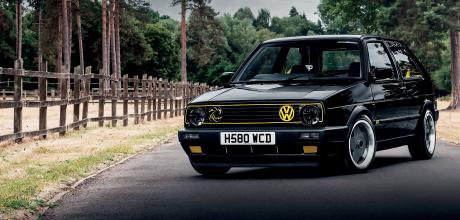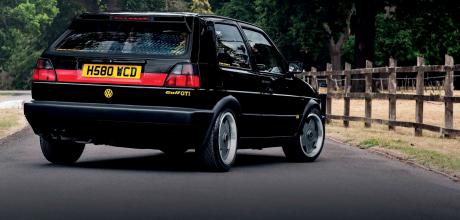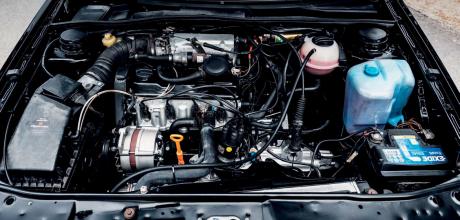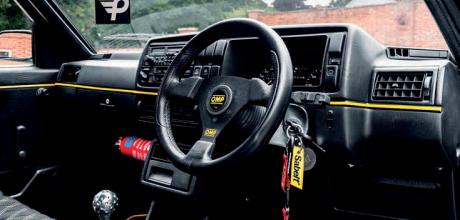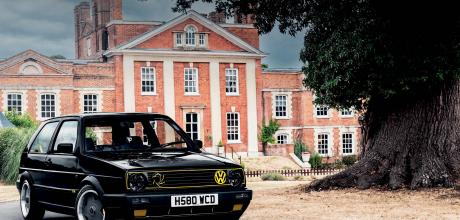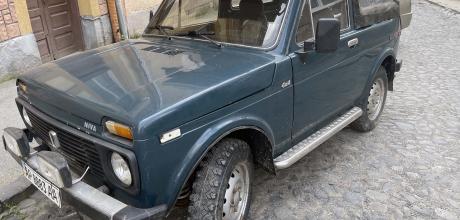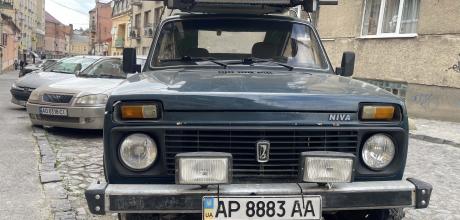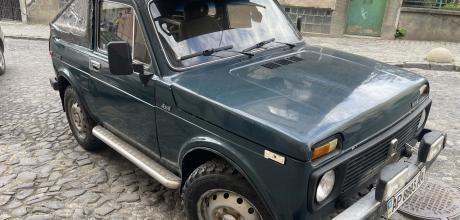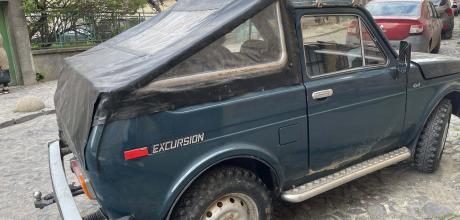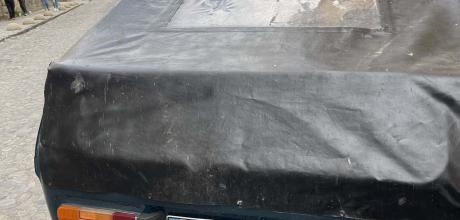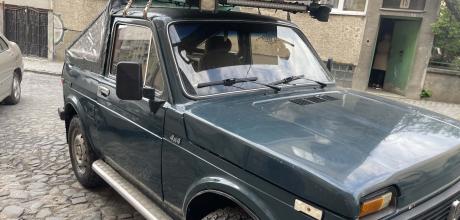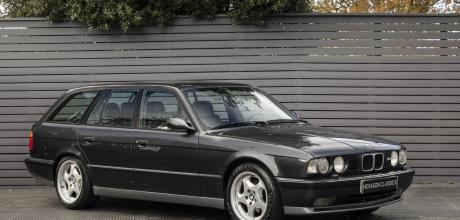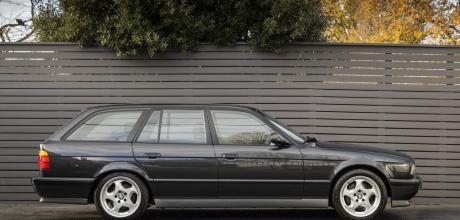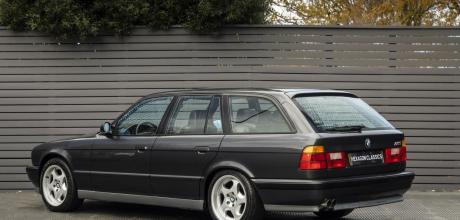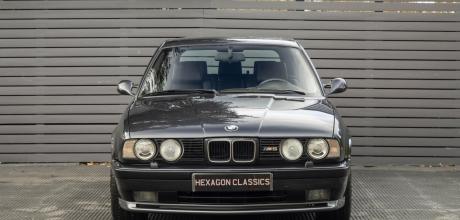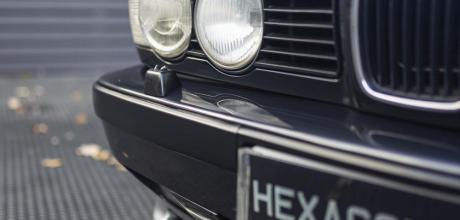8 photos
Volkswagen Golf Mk2 → Big bumpers, G60 arches 1.8 8v PB engined 1988 Volkswagen Golf GTi Mk2
When Tweaked Performance’s main man, Gerald Morten was considering a project car, he just had to scratch the Mk2 Golf GTI itch that had been bugging him for the last 40 years.
7 photos
The VAZ 2121 Niva Cabriolet is a convertible version of the VAZ 2121 Niva, which is a compact SUV produced by the Russian car manufacturer AvtoVAZ. The Niva Cabriolet was first introduced in 1993 and was in production until 2002.
The Niva Cabriolet featured a removable soft top, which allowed drivers to enjoy open-air driving. It was powered by a 1.7-liter gasoline engine that produced 80 horsepower and 94 lb-ft of torque. The engine was paired with a four-speed manual transmission and a full-time four-wheel drive system.
The Niva Cabriolet was known for its off-road capabilities and rugged design. It had a ground clearance of 22 cm, which allowed it to tackle tough terrain with ease. The Cabriolet also featured a basic interior with simple controls and functional features.
Today, the Niva Cabriolet has become somewhat of a cult classic among car enthusiasts, and it is highly sought after by collectors. Despite being out of production for over 20 years, it remains a popular choice for those who enjoy off-road driving and open-air motoring.
The Niva Cabriolet featured a removable soft top, which allowed drivers to enjoy open-air driving. It was powered by a 1.7-liter gasoline engine that produced 80 horsepower and 94 lb-ft of torque. The engine was paired with a four-speed manual transmission and a full-time four-wheel drive system.
The Niva Cabriolet was known for its off-road capabilities and rugged design. It had a ground clearance of 22 cm, which allowed it to tackle tough terrain with ease. The Cabriolet also featured a basic interior with simple controls and functional features.
Today, the Niva Cabriolet has become somewhat of a cult classic among car enthusiasts, and it is highly sought after by collectors. Despite being out of production for over 20 years, it remains a popular choice for those who enjoy off-road driving and open-air motoring.
38 photos
1994 BMW M5 Touring E34 -
BMW could have quite easily got away without producing the M5 Touring – the 540i was a pretty able performer in its own right – but the M5 should have demonstrated that there was definitely a market for this type of car. For some reason – and one suggests it was down to cost – BMW decided not to produce an E39 M5 Touring, and we had to wait another 12 years before there would be another M Touring when the E61 M5 was launched. The E34 M5 Touring could have launched a dynasty of fast M estates, but it wasn’t to be. In the intervening years, Audi managed to muscle in on the act, and, along with a few contenders from Mercedes AMG, more or less wrapped up the market for high-performance estates. Very much one of those Sliding Doors moments…
BMW could have quite easily got away without producing the M5 Touring – the 540i was a pretty able performer in its own right – but the M5 should have demonstrated that there was definitely a market for this type of car. For some reason – and one suggests it was down to cost – BMW decided not to produce an E39 M5 Touring, and we had to wait another 12 years before there would be another M Touring when the E61 M5 was launched. The E34 M5 Touring could have launched a dynasty of fast M estates, but it wasn’t to be. In the intervening years, Audi managed to muscle in on the act, and, along with a few contenders from Mercedes AMG, more or less wrapped up the market for high-performance estates. Very much one of those Sliding Doors moments…
41 photo
One of only eight Series I Ferrari 400 Superamerica SWBs with covered headlamps
Ferrari Classiche certified, confirming it to be a fully matching-numbers example
Boasting an unbroken chain of ownership and exhibited at a number of prestigious events including the Pebble Beach Concours d’Elegance
Short wheelbase and covered headlamps – the most desirable specification of the closed-coupé Ferrari 400 Superamericas
Dressed with a dramatic and desperately beautiful Pininfarina-designed Aerodinamico body, worthy of exhibition at the world’s greatest concours events including the Pebble Beach Concours d’Elegance and Concorso d’Eleganza Villa d’Este
The flagship twelve-cylinder Ferrari of the period, uniquely coach-built and sold to the marque’s most important clients with Enzo Ferrari’s personal blessing
The Ferrari 400 Superamerica
“Owning one should be the goal of every automotive enthusiast everywhere.” That’s how the famous American magazine Car & Driver summarised its in-depth review of the Ferrari 400 Superamerica back in 1963. Strong words indeed, but then this was no ordinary Prancing Horse.
The 400 Superamerica followed the tried-and-tested Gran Turismo recipe – one which, as the austerity of the War faded, was becoming more and more sought-after. Ferrari’s flagship model, it employed the legendary Colombo V12 in large four-litre form, a short- or long-wheelbase chassis, overdrive, disc brakes at all four corners (a first for a Ferrari road car) and a bespoke coupé or cabriolet body styled in a manner of different ways by Pininfarina.
Coach-built. We can’t emphasise enough how painstakingly built to the original owners’ exacting specifications these cars were. And said owners weren’t your average Ferrari customers – they were VIPs, loyal brand disciples, pop stars, captains of industry and even royals. Il Commendatore himself drove a 400 Superamerica. Need we say anymore?
Ferrari 400 Superamerica production was split into two series. The first, produced from 1959–1962, comprised a mere 15 short-wheelbase (2,400mm) cars, which were bestowed with a stunning Aerodinamico closed-coupé body by Pininfarina. It’s a dramatic design befitting of the world’s greatest motor show stands, with swooping curves, tapered overhangs, lashings of chrome and eleven exquisitely aligned vents in each of the front wings.
Chassis number 3559 SA
Even in the rarefied realms of the Ferrari 400 Superamerica, there are certain combinations of specification which, today, significantly increase the desirability. The car we’re honoured to be offering – chassis number 3559 SA – is one such example.
Crucially, this is one of only eight Ferrari 400 Superamericas Series Is ordered with covered headlamps – an option which, in our opinion, enhances the overall aesthetic harmony of the Aerodinamico coachwork.
The exhaustive build process began at the dawn of 1962 and this Ferrari was not signed off until July, by which point chassis number 3559 SA was resplendent in Blu Sera Italver over a Blu Connolly interior. The car was delivered new to Luigi Chinetti’s Ferrari concessionaire on the East Coast of America. Chinetti in turn found this 400 Superamerica its first home with one C. O. Marshall Jr. in Ohio.
Clearly fond of his flagship Ferrari, Marshall Jr. retained chassis 3559 SA for a decade, covering over 20,000 miles and even exhibiting it at the fifth Annual Ferrari Club of America meeting in 1968, where it won the Judges’ Choice award. The car remained in the United States under the stewardship of one further owner until 1989, at which point it was exported to Switzerland and acquired by Arnold and Walter Meier on the shores of Lake Zurich.
The Meiers were true disciples of the Prancing Horse, religiously maintaining the 400 Superamerica and, with a view to preserving the factory authenticity, commissioning a comprehensive restoration in 1993 with Edi Wyss Engineering in Switzerland.
The restoration complete, the Meiers transported the car back across the Atlantic, this time to the West Coast, and entered some of America’s greatest events, including the International Concours d’Elegance in Monterey and the Pebble Beach Concours d’Elegance, where chassis 3559 SA contested the ‘Ferrari Grand Touring Coupés up to 1968’ class in 1994.
Two years later, in 1997, Werner Meier drove this 400 Superamerica to the Ferrari 50th-anniversary celebration in Rome/Modena – a pilgrimage which, quite rightly, earned him and his beloved car a photo in that year’s Ferrari Yearbook.
The Meiers only parted with chassis 3559 SA in April of 2003, selling to a collector in Atlanta, Georgia. In 2011, the legendary American racing driver and racing school founder Skip Barber acquired this historically-significant Ferrari. His goal with the car was to win a revered Platinum Award at the world-famous Cavallino Classic in Florida and, with that in mind, he sent it to the Ferrari specialist Greg Jones to put it in the best possible stead.
The extensive work paid off, Barber clinching the Platinum Award at The Breakers in 2012. Of more importance was the Ferrari Classiche certification, which chassis 3559 SA subsequently received, confirming its matching-numbers chassis, engine, gearbox and differential.
This Ferrari 400 Superamerica was acquired by its current owner in 2013 and has since been carefully stored and seldomly driven. Today, the car is accompanied by its Ferrari Classiche certification binder.
In the period, these ultra-rare and highly exclusive flagship twelve-cylinder Ferrari Gran Turismos were the preserve of those who Enzo Ferrari personally held in the highest esteem – and were built to an accordingly high quality. Perhaps unsurprisingly, their stature in the market has remained lofty to this day, bolstered by their rarity, bespoke no-two-alike nature and, of course, exceptional beauty.
Chassis number 3559 SA distinguishes itself further with its unbroken chain of owners, each of whom fastidiously maintained it and exhibited it at prestigious events across the world, and its fully matching-numbers provenance. Whether you’re looking to reintroduce this 400 Superamerica Aerodinamico into the international concours circuit (to which it would be welcomed with open arms) or simply after a jaw-droppingly beautiful and astonishingly capable Gran Turismo for cross-continental jaunts, this is a Ferrari for the most discerning of collectors. In fact, 400 Superamericas reside in the world’s most prominent Ferrari collections. Here is an exceedingly rare chance to join them.
Year of manufacture - 7/1962
Car type - Coupé
Chassis number - 3559 SA
Engine number - 3559 SA
Electric windows - Yes
Reference number - CS244
Drive - LHD
Condition - Restored
Interior colour - Beige
Interior type - Leather
Number of doors - 2
Number of seats - 2
Location - United Kingdom
Exterior colour - Blue
Gearbox - Manual
Drivetrain - 2wd
Fuel type - Petrol
Ferrari Classiche certified, confirming it to be a fully matching-numbers example
Boasting an unbroken chain of ownership and exhibited at a number of prestigious events including the Pebble Beach Concours d’Elegance
Short wheelbase and covered headlamps – the most desirable specification of the closed-coupé Ferrari 400 Superamericas
Dressed with a dramatic and desperately beautiful Pininfarina-designed Aerodinamico body, worthy of exhibition at the world’s greatest concours events including the Pebble Beach Concours d’Elegance and Concorso d’Eleganza Villa d’Este
The flagship twelve-cylinder Ferrari of the period, uniquely coach-built and sold to the marque’s most important clients with Enzo Ferrari’s personal blessing
The Ferrari 400 Superamerica
“Owning one should be the goal of every automotive enthusiast everywhere.” That’s how the famous American magazine Car & Driver summarised its in-depth review of the Ferrari 400 Superamerica back in 1963. Strong words indeed, but then this was no ordinary Prancing Horse.
The 400 Superamerica followed the tried-and-tested Gran Turismo recipe – one which, as the austerity of the War faded, was becoming more and more sought-after. Ferrari’s flagship model, it employed the legendary Colombo V12 in large four-litre form, a short- or long-wheelbase chassis, overdrive, disc brakes at all four corners (a first for a Ferrari road car) and a bespoke coupé or cabriolet body styled in a manner of different ways by Pininfarina.
Coach-built. We can’t emphasise enough how painstakingly built to the original owners’ exacting specifications these cars were. And said owners weren’t your average Ferrari customers – they were VIPs, loyal brand disciples, pop stars, captains of industry and even royals. Il Commendatore himself drove a 400 Superamerica. Need we say anymore?
Ferrari 400 Superamerica production was split into two series. The first, produced from 1959–1962, comprised a mere 15 short-wheelbase (2,400mm) cars, which were bestowed with a stunning Aerodinamico closed-coupé body by Pininfarina. It’s a dramatic design befitting of the world’s greatest motor show stands, with swooping curves, tapered overhangs, lashings of chrome and eleven exquisitely aligned vents in each of the front wings.
Chassis number 3559 SA
Even in the rarefied realms of the Ferrari 400 Superamerica, there are certain combinations of specification which, today, significantly increase the desirability. The car we’re honoured to be offering – chassis number 3559 SA – is one such example.
Crucially, this is one of only eight Ferrari 400 Superamericas Series Is ordered with covered headlamps – an option which, in our opinion, enhances the overall aesthetic harmony of the Aerodinamico coachwork.
The exhaustive build process began at the dawn of 1962 and this Ferrari was not signed off until July, by which point chassis number 3559 SA was resplendent in Blu Sera Italver over a Blu Connolly interior. The car was delivered new to Luigi Chinetti’s Ferrari concessionaire on the East Coast of America. Chinetti in turn found this 400 Superamerica its first home with one C. O. Marshall Jr. in Ohio.
Clearly fond of his flagship Ferrari, Marshall Jr. retained chassis 3559 SA for a decade, covering over 20,000 miles and even exhibiting it at the fifth Annual Ferrari Club of America meeting in 1968, where it won the Judges’ Choice award. The car remained in the United States under the stewardship of one further owner until 1989, at which point it was exported to Switzerland and acquired by Arnold and Walter Meier on the shores of Lake Zurich.
The Meiers were true disciples of the Prancing Horse, religiously maintaining the 400 Superamerica and, with a view to preserving the factory authenticity, commissioning a comprehensive restoration in 1993 with Edi Wyss Engineering in Switzerland.
The restoration complete, the Meiers transported the car back across the Atlantic, this time to the West Coast, and entered some of America’s greatest events, including the International Concours d’Elegance in Monterey and the Pebble Beach Concours d’Elegance, where chassis 3559 SA contested the ‘Ferrari Grand Touring Coupés up to 1968’ class in 1994.
Two years later, in 1997, Werner Meier drove this 400 Superamerica to the Ferrari 50th-anniversary celebration in Rome/Modena – a pilgrimage which, quite rightly, earned him and his beloved car a photo in that year’s Ferrari Yearbook.
The Meiers only parted with chassis 3559 SA in April of 2003, selling to a collector in Atlanta, Georgia. In 2011, the legendary American racing driver and racing school founder Skip Barber acquired this historically-significant Ferrari. His goal with the car was to win a revered Platinum Award at the world-famous Cavallino Classic in Florida and, with that in mind, he sent it to the Ferrari specialist Greg Jones to put it in the best possible stead.
The extensive work paid off, Barber clinching the Platinum Award at The Breakers in 2012. Of more importance was the Ferrari Classiche certification, which chassis 3559 SA subsequently received, confirming its matching-numbers chassis, engine, gearbox and differential.
This Ferrari 400 Superamerica was acquired by its current owner in 2013 and has since been carefully stored and seldomly driven. Today, the car is accompanied by its Ferrari Classiche certification binder.
In the period, these ultra-rare and highly exclusive flagship twelve-cylinder Ferrari Gran Turismos were the preserve of those who Enzo Ferrari personally held in the highest esteem – and were built to an accordingly high quality. Perhaps unsurprisingly, their stature in the market has remained lofty to this day, bolstered by their rarity, bespoke no-two-alike nature and, of course, exceptional beauty.
Chassis number 3559 SA distinguishes itself further with its unbroken chain of owners, each of whom fastidiously maintained it and exhibited it at prestigious events across the world, and its fully matching-numbers provenance. Whether you’re looking to reintroduce this 400 Superamerica Aerodinamico into the international concours circuit (to which it would be welcomed with open arms) or simply after a jaw-droppingly beautiful and astonishingly capable Gran Turismo for cross-continental jaunts, this is a Ferrari for the most discerning of collectors. In fact, 400 Superamericas reside in the world’s most prominent Ferrari collections. Here is an exceedingly rare chance to join them.
Year of manufacture - 7/1962
Car type - Coupé
Chassis number - 3559 SA
Engine number - 3559 SA
Electric windows - Yes
Reference number - CS244
Drive - LHD
Condition - Restored
Interior colour - Beige
Interior type - Leather
Number of doors - 2
Number of seats - 2
Location - United Kingdom
Exterior colour - Blue
Gearbox - Manual
Drivetrain - 2wd
Fuel type - Petrol
10 photos
1973 Volvo 164 HD images
6 photos
The Moskvich 412 is a car produced by the Soviet/Russian car manufacturer, AZLK (later known as IzhAvto), from 1967 to 1976. It was an updated version of the previous Moskvich 408 model, featuring a new body design, more powerful engine, and improved suspension.
The Moskvich 412 was powered by a 1.5-liter, four-cylinder engine, which could produce up to 75 horsepower. It was available in both sedan and wagon body styles, and was widely used as a taxi in the Soviet Union.
Despite its popularity, the Moskvich 412 was known for its somewhat outdated design and limited reliability. However, it was considered a durable and affordable vehicle for its time, and became a symbol of Soviet-era transportation.
The Moskvich 412 was powered by a 1.5-liter, four-cylinder engine, which could produce up to 75 horsepower. It was available in both sedan and wagon body styles, and was widely used as a taxi in the Soviet Union.
Despite its popularity, the Moskvich 412 was known for its somewhat outdated design and limited reliability. However, it was considered a durable and affordable vehicle for its time, and became a symbol of Soviet-era transportation.
18 photos
ABF 2.0-litre engined 1985 Volkswagen Scirocco GL Mk2 Typ 53B
10 photos
1995 BMW 740i Automatic E38
9 photos
1983 Volkswagen Polo Coupe Mk2 Typ 86C
8 photos
Porsche 911 993 → Supercharged 400bhp 3.8-litre 1996 Porsche 911 993 RSR tribute
Supercharged 400bhp 3.8-litre 1996 Porsche 911 993 RSR tribute
44 photos
This has to be one of the most peculiar-looking cars ever to wear the Zagato badge - and that’s saying something. Autech was, in effect, Nissans bespoke department, which was known for all sorts - from preparing racing cars through to adapting vehicles for people with disabilities. The Stelvio was to be the first of a series of low-volume, luxuriously trimmed and exotically styled cars named after famous Italian passes.
14 photos
1971 OTAS Grand Prix Coupe LHD / 820 Tigre
17 photos
2001 BMW 530i Automatic M-Sport E39
4 photos
1984 ZAZ 968M Zaporozhets
7 photos
Ordered new by a Belgian monarch, this sole surviving Vignale-bodied Aston Martin DB2/4 is back on form after decades in the doldrums.
The all too-common plight of the show car and the one-off special is perfectly encapsulated in the rather sad story of chassis number LML/802, a Vignale-bodied Aston Martin DB2/4.
WHEN FELTHAM MET TURIN
Driving the sole surviving Vignale-bodied Aston Martin after an exacting restoration
Custom-built at the behest of 25-year-old King Baudouin of Belgium in the mid-1950s – doubtless at huge expense – it was reduced to the level of a discarded trinket by the beginning of the 1960s. Once the height of Turin chic, LML/802 was already, even then, the product of another era: a rapidly ageing, buxom show queen – too much jewellery, too much make-up – in an age of clean, flat-chested ’60s purity. As the smooth, simple, rounded Italian shapes of the early ’50s evolved to reflect the public fascination with all things erican and ‘jet age’, this Vignale-bodied Aston demonstrates the hall of mirrors that car styling had become. It was just a phase, of course, but one embraced by Alfredo Vignale (and his in-house stylist, Giovanni Michelotti) with more relish than most, which was perhaps one of the reasons why Vignale lost the patronage of Ferrari – in favour of Pinin Farina – in the second half of the ’50s.
Whatever the politics, it was still a time when the er elements of European royalty were powerfully attracted to the coachbuilding workshops of Turin, none more so than Leopold III of Belgium, who, along with his equally enthusiastic consort, Princess Lilian, ordered five one-off coachbuilt Ferraris between 1953 and ’68. Lilian was Baudouin’s stepmother: Princess Astrid of Sweden, his biological mother, had died in a car accident in 1935 when the king crashed his new Packard convertible into a tree on the banks of Lake Lucerne.
After 1945, Leopold III was not very popular in Belgium, where it was felt he had acquiesced to the Nazis a little too readily. In the face of civil unrest he abdicated in favour of his 21-yearold son, Baudouin, in 1951. Once less in the public eye, the former king probably felt more able to indulge in exotic cars. The most famous of these was an all-black roadgoing Ferrari 375 Plus Cabriolet by Pinin Farina, although arguably the most beautiful was the special 330GTC built for the princess in 1968.
Not that the tall, bespectacled Baudouin was exactly immune to the charms of expensive motor cars. He had grown up around his father’s Bugattis (there’s a family snap of him sitting in a Type 52 ‘Baby’) and he is known to have owned a Porsche 550 and various Maseratis, although he was latterly associated with rather more statesmanlike vehicles: a Mercedes 600 Pullman, clap-door Lincoln and a variety of Cadillacs are all attributed to him. The Belgians have always had a strong allegiance to American cars.
Why he chose an Aston Martin – rather than a Ferrari or a Maserati – as the basis for his ‘statement’ car is hard to fathom at a distance of almost 70 years. But it was a legitimate enough choice, given that the Aston name was coming to greater prominence in racing and the DB2/4 was acknowledged to be one of the world’s best and fastest production grand touring cars. The link with Vignale is obvious because the body of his stepmother’s recently delivered Ferrari 250GT coupé had been created at the famous workshops on the Via Cigliano, Turin.
Designed by the prolific Michelotti, it was to be the final Vignale-bodied Ferrari of the 1950s. The princess, accompanied by Formula One World Champion Nino Farina, had even visited the carrozzeria to see it being built. LML/802 was one of a dozen left-hand-drive DB2/4 rolling chassis supplied by the Feltham works to European coachbuilders. Eight of these are attributed to Bertone, but Graber, Touring, mano and Ghia also did one each, which makes 14 special-bodied DB2/4s, by my sums, including the two Vignales – a twin of the Baudouin Vignale DB2/4 was also built, for a French customer, but is now presumed lost. Powered by the latest 140bhp 3-litre engine, LML/802 had the longer of the optional axle ratios. The factory chassis card only notes that the wire wheels are ‘partially chromed’. The body, hand-beaten from aluminium with an ash frame, was six months in the making and the king took delivery in March 1955. Vignale used the car in its advertising, describing the Aston as: ‘A two-seater coupé provided to a high European personality.’ Just a month earlier, Baudouin had acquired a standard 3-litre DB2/4, supplied by Belgian concessionaire Mannes but delivered to the the factory DB2/4 ran ‘CD’ diplomatic plates. While he apparently kept the standard car for decades (the first change of ownership is recorded as being in 1989), the Vignale DB2/4 fell out of favour much more rapidly: it was sold at an indeterminate point in the late 1950s to palace aide TR Mottershead. Nothing much is known of this character, other than the fact that he stored the car in Moselle, France. Here a man called James Toth enters the story. As an American solider working for NATO in Paris, Toth later discovered the Vignale in a back-street garage. Having captured LML/802, he managed to do terminal harm to both its original engine and its replacement in fairly short order, before giving up and selling the non-running DB2/4 to an army captain. Period black-and-white photographs show the Vignale Aston Martin less its front bumper at this point, and in a single-tone colour scheme. America – and the inevitable V8 conversion – beckoned, and from there it was a relatively short trip to the breaker’s yard for LML/802, whose brief moment of fame had long been forgotten. Then, at some point in the early 1990s, the Vignale Aston’s luck began to improve. It was rescued from a scrapyard in Virginia, still fitted with a Pontiac V8 engine and rear axle, by one Roland Wommack. In the middle of the decade, Wommack sold the car to Bob Fountain of the Aston Workshop in Beamish, County Durham. The Italian DB2/4 then languished some more after Fountain’s original idea of selling the car as a project proved tricky: one-offs tend to excite historians, but not paying customers. In the age of the internet the full significance of the Vignale soon dawned, however, and it appeared to Fountain that the only proper thing to do was restore the car with or without a buyer lined up. The good news was that the body and the chassis were remarkably sound, requiring only localised repairs, and most of the important unique brightwork had survived. The bad news was that the interior of the car was largely missing and had to be recreated from period photographs, and this, predictably, was by far the trickiest part of the restoration.
The all too-common plight of the show car and the one-off special is perfectly encapsulated in the rather sad story of chassis number LML/802, a Vignale-bodied Aston Martin DB2/4.
WHEN FELTHAM MET TURIN
Driving the sole surviving Vignale-bodied Aston Martin after an exacting restoration
Custom-built at the behest of 25-year-old King Baudouin of Belgium in the mid-1950s – doubtless at huge expense – it was reduced to the level of a discarded trinket by the beginning of the 1960s. Once the height of Turin chic, LML/802 was already, even then, the product of another era: a rapidly ageing, buxom show queen – too much jewellery, too much make-up – in an age of clean, flat-chested ’60s purity. As the smooth, simple, rounded Italian shapes of the early ’50s evolved to reflect the public fascination with all things erican and ‘jet age’, this Vignale-bodied Aston demonstrates the hall of mirrors that car styling had become. It was just a phase, of course, but one embraced by Alfredo Vignale (and his in-house stylist, Giovanni Michelotti) with more relish than most, which was perhaps one of the reasons why Vignale lost the patronage of Ferrari – in favour of Pinin Farina – in the second half of the ’50s.
Whatever the politics, it was still a time when the er elements of European royalty were powerfully attracted to the coachbuilding workshops of Turin, none more so than Leopold III of Belgium, who, along with his equally enthusiastic consort, Princess Lilian, ordered five one-off coachbuilt Ferraris between 1953 and ’68. Lilian was Baudouin’s stepmother: Princess Astrid of Sweden, his biological mother, had died in a car accident in 1935 when the king crashed his new Packard convertible into a tree on the banks of Lake Lucerne.
After 1945, Leopold III was not very popular in Belgium, where it was felt he had acquiesced to the Nazis a little too readily. In the face of civil unrest he abdicated in favour of his 21-yearold son, Baudouin, in 1951. Once less in the public eye, the former king probably felt more able to indulge in exotic cars. The most famous of these was an all-black roadgoing Ferrari 375 Plus Cabriolet by Pinin Farina, although arguably the most beautiful was the special 330GTC built for the princess in 1968.
Not that the tall, bespectacled Baudouin was exactly immune to the charms of expensive motor cars. He had grown up around his father’s Bugattis (there’s a family snap of him sitting in a Type 52 ‘Baby’) and he is known to have owned a Porsche 550 and various Maseratis, although he was latterly associated with rather more statesmanlike vehicles: a Mercedes 600 Pullman, clap-door Lincoln and a variety of Cadillacs are all attributed to him. The Belgians have always had a strong allegiance to American cars.
Why he chose an Aston Martin – rather than a Ferrari or a Maserati – as the basis for his ‘statement’ car is hard to fathom at a distance of almost 70 years. But it was a legitimate enough choice, given that the Aston name was coming to greater prominence in racing and the DB2/4 was acknowledged to be one of the world’s best and fastest production grand touring cars. The link with Vignale is obvious because the body of his stepmother’s recently delivered Ferrari 250GT coupé had been created at the famous workshops on the Via Cigliano, Turin.
Designed by the prolific Michelotti, it was to be the final Vignale-bodied Ferrari of the 1950s. The princess, accompanied by Formula One World Champion Nino Farina, had even visited the carrozzeria to see it being built. LML/802 was one of a dozen left-hand-drive DB2/4 rolling chassis supplied by the Feltham works to European coachbuilders. Eight of these are attributed to Bertone, but Graber, Touring, mano and Ghia also did one each, which makes 14 special-bodied DB2/4s, by my sums, including the two Vignales – a twin of the Baudouin Vignale DB2/4 was also built, for a French customer, but is now presumed lost. Powered by the latest 140bhp 3-litre engine, LML/802 had the longer of the optional axle ratios. The factory chassis card only notes that the wire wheels are ‘partially chromed’. The body, hand-beaten from aluminium with an ash frame, was six months in the making and the king took delivery in March 1955. Vignale used the car in its advertising, describing the Aston as: ‘A two-seater coupé provided to a high European personality.’ Just a month earlier, Baudouin had acquired a standard 3-litre DB2/4, supplied by Belgian concessionaire Mannes but delivered to the the factory DB2/4 ran ‘CD’ diplomatic plates. While he apparently kept the standard car for decades (the first change of ownership is recorded as being in 1989), the Vignale DB2/4 fell out of favour much more rapidly: it was sold at an indeterminate point in the late 1950s to palace aide TR Mottershead. Nothing much is known of this character, other than the fact that he stored the car in Moselle, France. Here a man called James Toth enters the story. As an American solider working for NATO in Paris, Toth later discovered the Vignale in a back-street garage. Having captured LML/802, he managed to do terminal harm to both its original engine and its replacement in fairly short order, before giving up and selling the non-running DB2/4 to an army captain. Period black-and-white photographs show the Vignale Aston Martin less its front bumper at this point, and in a single-tone colour scheme. America – and the inevitable V8 conversion – beckoned, and from there it was a relatively short trip to the breaker’s yard for LML/802, whose brief moment of fame had long been forgotten. Then, at some point in the early 1990s, the Vignale Aston’s luck began to improve. It was rescued from a scrapyard in Virginia, still fitted with a Pontiac V8 engine and rear axle, by one Roland Wommack. In the middle of the decade, Wommack sold the car to Bob Fountain of the Aston Workshop in Beamish, County Durham. The Italian DB2/4 then languished some more after Fountain’s original idea of selling the car as a project proved tricky: one-offs tend to excite historians, but not paying customers. In the age of the internet the full significance of the Vignale soon dawned, however, and it appeared to Fountain that the only proper thing to do was restore the car with or without a buyer lined up. The good news was that the body and the chassis were remarkably sound, requiring only localised repairs, and most of the important unique brightwork had survived. The bad news was that the interior of the car was largely missing and had to be recreated from period photographs, and this, predictably, was by far the trickiest part of the restoration.



